 [Image: The face of Nicholson Crater, Mars, courtesy of the ESA].
[Image: The face of Nicholson Crater, Mars, courtesy of the ESA].
According to The New York Times Book Review, the novels of Nebula and Hugo Award-winning author Kim Stanley Robinson “constitute one of the most impressive bodies of work in modern science fiction.” I might argue, however, that Robinson is fundamentally a landscape writer.
That is, Robinson’s books are not only filled with descriptions of landscapes – whole planets, in fact, noted, sensed, and textured down to the chemistry of their soils and the currents in their seas – but his novels are often about nothing other than vast landscape processes, in the midst of which a few humans stumble along. “Politics,” in these novels, is as much a question of social justice as it is shorthand for learning to live in specific environments.
 In his most recent trilogy – Forty Signs of Rain, Fifty Degrees Below, and Sixty Days and Counting – we see the earth becoming radically unlike itself through climate change. Floods drown the U.S. capital; fierce winter ice storms leave suburban families powerless, in every sense of the word; and the glaciers of concrete and glass that we have mistaken for civilization begin to reveal their inner weaknesses.
In his most recent trilogy – Forty Signs of Rain, Fifty Degrees Below, and Sixty Days and Counting – we see the earth becoming radically unlike itself through climate change. Floods drown the U.S. capital; fierce winter ice storms leave suburban families powerless, in every sense of the word; and the glaciers of concrete and glass that we have mistaken for civilization begin to reveal their inner weaknesses.
The stand-alone novel Antarctica documents the cuts, bruises, and theoretical breakthroughs of environmental researchers as they hike, snowshoe, sledge, belay, and fly via helicopter over the fractured canyons and crevasses of the southern continent. They wander across “shear zones” and find rooms buried in the ice, natural caves linked together like a “shattered cathedral, made of titanic columns of driftglass.”
Meanwhile, in Robinson’s legendary Mars Trilogy – Red Mars, Blue Mars, and Green Mars – the bulk of the narrative is, again, complete planetary transformation, this time on Mars. The Red Planet, colonized by scientists, is deliberately remade – or terraformed – to be climatically, hydrologically, and agriculturally suited for human life. Yet this is a different kind of human life – it, too, has been transformed: politically and psychologically.
In his recent book Archaeologies of the Future: The Desire Called Utopia and Other Science Fictions, Fredric Jameson devotes an entire chapter to Robinson’s Mars Trilogy. Jameson writes that “utopia as a form is not the representation of radical alternatives; it is rather simply the imperative to imagine them.”
Across all his books, Robinson is never afraid to imagine these radical alternatives. Indeed, in the interview posted below he explains that “I’ve been working all my career to try to redefine utopia in more positive terms – in more dynamic terms.”
 In the following interview, then, Kim Stanley Robinson talks to BLDGBLOG about climate change, from Hurricane Katrina to J.G. Ballard; about the influence of Greek island villages on his descriptions of Martian base camps; about life as a 21st century primate in the 24/7 “techno-surround”; how we must rethink utopia as we approach an age without oil; whether “sustainability” is really the proper thing to be striving for; and what a future archaeology of the space age might find.
In the following interview, then, Kim Stanley Robinson talks to BLDGBLOG about climate change, from Hurricane Katrina to J.G. Ballard; about the influence of Greek island villages on his descriptions of Martian base camps; about life as a 21st century primate in the 24/7 “techno-surround”; how we must rethink utopia as we approach an age without oil; whether “sustainability” is really the proper thing to be striving for; and what a future archaeology of the space age might find.
This interview also includes previously unpublished photos by Robinson himself, taken in Greece and Antarctica.
• • •BLDGBLOG: I’m interested in the possibility that literary genres might have to be redefined in light of climate change. In other words, a novel where two feet of snow falls on Los Angeles, or sand dunes creep through the suburbs of Rome, would be considered a work of science fiction, even surrealism, today; but that same book, in fifty years’ time, could very well be a work of
climate realism, so to speak. So if climate change is making the world
surreal, then what it means to write a “realistic” novel will have to change. As a science fiction novelist, does that affect how you approach your work?
Kim Stanley Robinson: Well, I’ve been saying this for a number of years: that now we’re all living in a science fiction novel together, a book that we co-write. A lot of what we’re experiencing now is unsurprising because we’ve been prepped for it by science fiction. But I don’t think surrealism is the right way to put it. Surrealism is so often a matter of dreamscapes, of things becoming more than real – and, as a result, more sublime. You think, maybe, of J.G. Ballard’s The Drowned World, and the way that he sees these giant catastrophes as a release from our current social set-up: catastrophe and disaster are aestheticized and looked at as a miraculous salvation from our present reality. But it wouldn’t really be like that.
I started writing about Earth’s climate change in the Mars books. I needed something to happen on Earth that was shocking enough to allow a kind of historical gap in which my Martians could realistically establish independence. I had already been working with Antarctic scientists who were talking about the West Antarctic Ice Sheet, and how unstable it might be – so I used that, and in Blue Mars I showed a flooded London. But after you get past the initial dislocations and disasters, what you’ve got is another landscape to be inhabited – another situation that would have its own architecture, its own problems, and its own solutions.
To a certain extent, later, in my climate change books, I was following in that mold with the flood of Washington DC. I wrote that scene before Katrina. After Katrina hit, my flood didn’t look the same. I think it has to be acknowledged that the use of catastrophe as a literary device is not actually adequate to talk about something which, in the real world, is often so much worse – and which comes down to a great deal of human suffering.
So there may have been surreal images coming out of the New Orleans flood, but that’s not really what we take away from it.
 [Image: Refugees gather outside the Superdome, New Orleans, post-Katrina].
[Image: Refugees gather outside the Superdome, New Orleans, post-Katrina].
BLDGBLOG: Aestheticizing these sorts of disasters can also have the effect of making climate change sound like an adventure. In Fifty Degrees Below, for instance, you wrote: “People are already fond of the flood… It was an adventure. It got people out of their ruts.” The implication is that people might actually be excited about climate change. Is there a risk that all these reports about flooded cities and lost archipelagoes and new coastlines might actually make climate change sound like some sort of survivalist adventure?
Robinson: It’s a failure of imagination to think that climate change is going to be an escape from jail – and it’s a failure in a couple of ways.
For one thing, modern civilization, with six billion people on the planet, lives on the tip of a gigantic complex of prosthetic devices – and all those devices have to work. The crash scenario that people think of, in this case, as an escape to freedom would actually be so damaging that it wouldn’t be fun. It wouldn’t be an adventure. It would merely be a struggle for food and security, and a permanent high risk of being robbed, beaten, or killed; your ability to feel confident about your own – and your family’s and your children’s – safety would be gone. People who fail to realize that… I’d say their imaginations haven’t fully gotten into this scenario.
It’s easy to imagine people who are bored in the modern techno-surround, as I call it, and they’re bored because they have not fully comprehended that they’re still primates, that their brains grew over a million-year period doing a certain suite of activities, and those activities are still available. Anyone can do them; they’re simple. They have to do with basic life support and basic social activities unboosted by technological means.
And there’s an addictive side to this. People try to do stupid technological replacements for natural primate actions, but it doesn’t quite give them the buzz that they hoped it would. Even though it looks quite magical, the sense of accomplishment is not there. So they do it again, hoping that the activity, like a drug, will somehow satisfy the urge that it’s supposedly meant to satisfy. But it doesn’t. So they do it more and more – and they fall down a rabbit hole, pursuing a destructive and high carbon-burn activity, when they could just go out for a walk, or plant a garden, or sit down at a table with a friend and drink some coffee and talk for an hour. All of these unboosted, straight-forward primate activities are actually intensely satisfying to the totality of the mind-body that we are.
So a little bit of analysis of what we are as primates – how we got here evolutionarily, and what can satisfy us in this world – would help us to imagine activities that are much lower impact on the planet and much more satisfying to the individual at the same time. In general, I’ve been thinking: let’s rate our technologies for how much they help us as primates, rather than how they can put us further into this dream of being powerful gods who stalk around on a planet that doesn’t really matter to us.
Because a lot of these supposed pleasures are really expensive. You pay with your life. You pay with your health. And they don’t satisfy you anyway! You end up taking various kinds of prescription or non-prescription drugs to compensate for your unhappiness and your unhealthiness – and the whole thing comes out of a kind of spiral: if only you could consume more, you’d be happier. But it isn’t true.
I’m advocating a kind of alteration of our imagined relationship to the planet. I think it’d be more fun – and also more sustainable. We’re always thinking that we’re much more powerful than we are, because we’re boosted by technological powers that exert a really, really high cost on the environment – a cost that isn’t calculated and that isn’t put into the price of things. It’s exteriorized from our fake economy. And it’s very profitable for certain elements in our society for us to continue to wander around in this dream-state and be upset about everything.
The hope that, “Oh, if only civilization were to collapse, then I could be happy” – it’s ridiculous. You can simply walk out your front door and get what you want out of that particular fantasy.
 [Image: New Orleans under water, post-Katrina; photographer unknown].
[Image: New Orleans under water, post-Katrina; photographer unknown].
BLDGBLOG: Mars has a long history as a kind of utopian destination – and, in that, your Mars trilogy is no exception. What is it about Mars that brings out this particular kind of speculation?
Robinson: Well, it brings up an unusual modern event that can happen in our mental landscapes, which is comparative planetology. That wasn’t really available to us before the modern era – really, until Viking.
One thing about Mars is that it’s a radically impoverished landscape. You start with nothing – the bare rock, the volatile chemicals that are needed for life, some water, and an empty landscape. That makes it a kind of gigantic metaphor, or modeling exercise, and it gives you a way to imagine the fundamentals of what we’re doing here on Earth. I find it is a very good thing to begin thinking that we are terraforming Earth – because we are, and we’ve been doing it for quite some time. We’ve been doing it by accident, and mostly by damaging things. In some ways, there have been improvements, in terms of human support systems, but there’s still so much damage, damage that’s gone unacknowledged or ignored, even when all along we knew it was happening. People kind of shrug and think: a) there’s nothing we can do about it, or b) maybe the next generation will be clever enough to figure it out. So on we go.




 [Images: Mars, courtesy of NASA].
[Images: Mars, courtesy of NASA].
Mars is an interesting platform where we can model these things. But I don’t know that we’ll get there for another fifty years or so – and once we do get there, I think that for many, many years, maybe many decades, it will function like Antarctica does now: it will be an interesting scientific base that teaches us things and is beautiful and charismatic, but not important in the larger scheme of human history on Earth. It’s just an interesting place to study, that we can learn things from. Actually, for many years, Mars will be even less important to us than Antarctica, because the Antarctic is at least part of our ecosphere.
But if you think of yourself as terraforming Earth, and if you think about sustainability, then you can start thinking about permaculture and what permaculture really means. It’s not just sustainable agriculture, but a name for a certain type of history. Because the word sustainability is now code for: let’s make capitalism work over the long haul, without ever getting rid of the hierarchy between rich and poor and without establishing social justice.
Sustainable development, as well: that’s a term that’s been contaminated. It doesn’t even mean sustainable anymore. It means: let us continue to do what we’re doing, but somehow get away with it. By some magic waving of the hands, or some techno silver bullet, suddenly we can make it all right to continue in all our current habits. And yet it’s not just that our habits are destructive, they’re not even satisfying to the people who get to play in them. So there’s a stupidity involved, at the cultural level.
BLDGBLOG: In other words, your lifestyle may now be carbon neutral – but was it really any good in the first place?
Robinson: Right. Especially if it’s been encoding, or essentially legitimizing, a grotesque hierarchy of social injustice of the most damaging kind. And the tendency for capitalism to want to overlook that – to wave its hands and say: well, it’s a system in which eventually everyone gets to prosper, you know, the rising tide floats all boats, blah blah – well, this is just not true.
We should take the political and aesthetic baggage out of the term utopia. I’ve been working all my career to try to redefine utopia in more positive terms – in more dynamic terms. People tend to think of utopia as a perfect end-stage, which is, by definition, impossible and maybe even bad for us. And so maybe it’s better to use a word like permaculture, which not only includes permanent but also permutation. Permaculture suggests a certain kind of obvious human goal, which is that future generations will have at least as good a place to live as what we have now.
It’s almost as if a science fiction writer’s job is to represent the unborn humanity that will inherit this place – you’re speaking from the future and for the future. And you try to speak for them by envisioning scenarios that show them either doing things better or doing things worse – but you’re also alerting the generations alive right now that these people have a voice in history.
The future needs to be taken into account by the current system, which regularly steals from it in order to pad our ridiculous current lifestyle.
 [Images: (top) Michael Reynolds, architect. Turbine House, Taos, New Mexico. Photograph © Michael Reynolds, 2007. (bottom) Steve Baer, designer. House of Steve Baer, Corrales, New Mexico, 1971. Photography © Jon Naar, 1975/2007. Courtesy of the Canadian Centre for Architecture, from their excellent, and uncannily well-timed, exhibition 1973: Sorry, Out of Gas].
[Images: (top) Michael Reynolds, architect. Turbine House, Taos, New Mexico. Photograph © Michael Reynolds, 2007. (bottom) Steve Baer, designer. House of Steve Baer, Corrales, New Mexico, 1971. Photography © Jon Naar, 1975/2007. Courtesy of the Canadian Centre for Architecture, from their excellent, and uncannily well-timed, exhibition 1973: Sorry, Out of Gas].
BLDGBLOG: When it actually comes to designing the future, what will permaculture look like? Where will its structures and ideas come from?
Robinson: Well, at the end of the 1960s and through the 70s, what we thought – and this is particularly true in architecture and design terms – was: OK, given these new possibilities for new and different ways of being, how do we design it? What happens in architecture? What happens in urban design?
As a result of these questions there came into being a big body of utopian design literature that’s now mostly obsolete and out of print, which had no notion that the Reagan-Thatcher counter-revolution was going to hit. Books like Progress As If Survival Mattered, Small Is Beautiful, Muddling Toward Frugality, The Integral Urban House, Design for the Real World, A Pattern Language, and so on. I had a whole shelf of those books. Their tech is now mostly obsolete, superceded by more sophisticated tech, but the ideas behind them, and the idea of appropriate technology and alternative design: that needs to come back big time. And I think it is.
 [Image: American President Jimmy Carter dedicates the White House solar panels, 20 June 1979. Photograph © Jimmy Carter Library. Courtesy of the Canadian Centre for Architecture].
[Image: American President Jimmy Carter dedicates the White House solar panels, 20 June 1979. Photograph © Jimmy Carter Library. Courtesy of the Canadian Centre for Architecture].
This is one of the reasons I’ve been talking about climate change, and the possibility of abrupt climate change, as potentially a good thing – in that it forces us to confront problems that we were going to sweep under the carpet for hundreds of years. Now, suddenly, these problems are in our face and we have to deal. And part of dealing is going to be design.
I don’t think people fully comprehend what a gigantic difference their infrastructure makes, or what it feels like to live in a city with public transport, like Paris, compared to one of the big autopias like southern California. The feel of existence is completely different. And of course the carbon burn is also different – and the sense that everybody’s in the same boat together. This partly accounts for the difference between urban voters and rural voters: rural voters – or out-in-the-country voters – can imagine that they’re somehow independent, and that they don’t rely on other people. Meanwhile, their entire tech is built elsewhere. It’s a fantasy, and a bad one as it leads to a false assessment of the real situation.
The Mars books were where I focused on these design questions the most. I had to describe fifteen or twenty invented towns or social structures based around their architecture. Everything from little settlements to crater towns to gigantic cities, to all sorts of individual homes in the outback – how do you occupy the outback? how do you live? – and it was a great pleasure. I think, actually, that one of the main reasons people enjoyed those Mars books was in seeing these alternative design possibilities envisioned and being able to walk around in them, imaginatively.
BLDGBLOG: Were there specific architectural examples, or specific landscapes, that you based your descriptions on?
Robinson: Sure. They had to do with things that I’d seen or read about. And, you know, reading Science News week in and week out, I was always attentive to what the latest in building materials or house design was.
Also, I seized on anything that seemed human-scale and aesthetically pleasing and good for a community. I thought of Greek villages in Crete, and also the spectacular stuff on Santorini. One of the things I learned, wandering around Greek archaeological sites – I’m very interested in archaeology – is that they clearly chose some of their town sites not just for practical concerns but also for aesthetic pleasure. They would put their towns in places where it would look good to live – where you would get a permanent sense that the town was a work of art, as well as a practical solution to economic and geographical problems. That was something I wanted to do on Mars over and over again.
 [Image: Photos of Greece, inspiration for life on Mars, taken by Kim Stanley Robinson].
[Image: Photos of Greece, inspiration for life on Mars, taken by Kim Stanley Robinson].
Mondragon, Spain, was also a constant reference point, and Kerala, in southern India. I was looking at cooperative, or leftist, places. Bologna, Italy. The Italian city-states of the Renaissance, in a different kind of way. Also, cities where public transport on a human scale could be kept in mind. That’s mostly northern Europe.
So those were some of the reference points that I remember – but I was also trying to think about how humans might inhabit the unusual Martian features: the cliffsides, the hidden cities that I postulated might be necessary. I was attracted to anything that had to do with circularity, because of the stupendous number of craters on Mars. The Paul Sattelmeier indoor/outdoor house, which is round and easy to build, was something I noticed in Science News as a result of this fixation.
There was a real wide net I could cast there – and it was fun. If you give yourself a whole world to play with, you don’t have to choose just one solution – you can describe any number of solutions – and I think that was politically true as well as architecturally true with my Mars books. They weren’t proposing one master solution, as in the old utopias, but showing that there are a variety of possible solutions, with different advantages and disadvantages.
 [Image: A photograph of Santorini taken by Kim Stanley Robinson].
[Image: A photograph of Santorini taken by Kim Stanley Robinson].
BLDGBLOG: Speaking of archaeology, one of the most interesting things I’ve read recently was that some archaeologists are now speculating that sites like the Apollo moon landing, or the final resting spot of the Mars rovers, will someday be like Egypt’s Valley of the Kings: they’ll be excavated and studied and preserved and mapped.
Robinson: Yes, and places like Baikonur, in Kazakhstan, will be quite beautiful. They’ll work as great statuary – like megaliths. They’ll have that charismatic quality and, in their ruin, they should be quite beautiful. As you know, that was one great attraction of the Romantic era – to ruins, to the suggestion of age – and there will be something nicely contradictory about something as futuristic as space artifacts suggesting ruins and the ancient past. That’s sure to come.
The interesting problem on Mars, and Chris McKay has talked about this, is that if we conclude that there’s the possibility of bacterial life on Mars, then it becomes really, really important for us not to contaminate the planet with earthly bacteria. But it’s almost impossible to sterilize a spaceship completely. There were probably 100,000 bacteria even on the sterilized spacecraft that we sent to Mars, living on their inner surfaces. It isn’t even certain that a gigantic crash-landing and explosion would kill all that bacteria.
So Chris McKay has been suggesting that a site like the Beagle or polar lander crash site actually needs to be excavated and fully sterilized – the stuff may even have to be taken off-planet – if we really want to keep Mars uncontaminated. In other words, we’ve contaminated it already; if we find native, alien bacterial life on Mars, and we don’t want it mixed up with Terran life, then we might have to do something a lot more radical than an archaeological saving of the site. We might have to do something like a Superfund clean-up.
Of course, that’s all really hard to do without getting down there with yet more bacteria-infested things.

 [Image: Two painted views of a human future on Mars, courtesy of NASA].
[Image: Two painted views of a human future on Mars, courtesy of NASA].
BLDGBLOG: That’s the same situation as with these lakes in Antarctica buried beneath the ice: to study them, we have to drill down into them, but by drilling down into them, we might immediately introduce microbes and bacteria and even chemicals into the water – which will mean that there’s not much left for us to study.
Robinson: They’re already having that problem with Lake Vostok. The Russians have got an ice drill that’s already maybe too close to the lake, and in the sphere of influence of the trapped bacteria. And now people are calculating that the water in Lake Vostok might be very heavily pressurized, and like seltzer water, so that breaking through might cause a gusher on the surface that could last six months. The water might just fly out onto the surface – where it would freeze and create a little mountain up there, of fresh water. Who knows? I mean, at that point, whatever was going on, in bacterial terms, with that lake in particular – that’s ruined. There are many other lakes beneath the Antarctic surface, so it isn’t as if we don’t have more places we could save or study, but that one is already a problem.
 [Image: Architecture in Antarctica, photographed by Kim Stanley Robinson].
[Image: Architecture in Antarctica, photographed by Kim Stanley Robinson].
Also, I do like the archaeological sites in Antarctica from the classic era. Those are worth comparing to the space program. Going to Antarctica in 1900 was like us going into space today: as Oliver Morton has put it, it was the hardest thing that technology allowed humans to do at the time. So you could imagine those guys as being in space suits and doing space station-type stuff – but, of course, from our angle, it looks like Boy Scout equipment. It’s amazing that they got away with it at all. Those are the most beautiful spaces – the Shackleton/Scott sites – even the little cairns that Amundsen left behind, or the crashed airplanes from the 1920s: they all become vividly important reminders of our past and of our technological progress. They deserve to be protected fully and kind of revered, almost as religious sites, if you’re a humanist.
 [Image: Shackleton’s hut, Antarctica, photographed by Kim Stanley Robinson].
[Image: Shackleton’s hut, Antarctica, photographed by Kim Stanley Robinson].
So archaeology in space? Who knows? It’s hard enough to think about what’s going to go on up there. But on earth it’s very neat to think of Cape Canaveral or Baikonur becoming like Shackleton’s hut.
Thinking along this line causes me to wonder about the Stalinist industrial cities in the Urals – you know, like Chelyabinsk-65. These horribly utilitarian extraction economy-type places, incredibly brutal and destructive – once they’re abandoned, and they begin to rust away, they take on a strange kind of aesthetic. As long as you wouldn’t get actively poisoned when you visit them –
BLDGBLOG: [laughs]
Robinson: – I would be really interested to see some of these places. Just don’t step in the sludge, or scratch your arm – the toxicity levels are supposed to be alarming. But, in archaeological terms, I bet they’d be beautiful.
• • •BLDGBLOG owes a huge and genuine thanks to Kim Stanley Robinson, not only for his ongoing output as a writer but for his patience while this interview was edited and assembled. Thanks, as well, to
William L. Fox for putting Robinson and I in touch in the first place.
Meanwhile, the
recently published catalog for the exhibition
1973: Sorry, Out of Gas offers a great look at the “big body of utopian design literature that’s now mostly obsolete and out of print” that Robinson mentions in the above interview. If you see a copy, I’d definitely recommend settling in for a long read.

 [Image: Surveillance cameras for sale in China; photo by Timothy O’Rourke for
[Image: Surveillance cameras for sale in China; photo by Timothy O’Rourke for  [Image: Surveillance in China; photographer temporarily unknown, though this appeared in
[Image: Surveillance in China; photographer temporarily unknown, though this appeared in  [Image: The diagrammatic mathematics of a structural experiment by
[Image: The diagrammatic mathematics of a structural experiment by  [Image: Two abstract stacks by
[Image: Two abstract stacks by  [Image: May the force stack with you; diagram by
[Image: May the force stack with you; diagram by  [Image: More stack madness by
[Image: More stack madness by  [Image: London’s P&O Building gets demolished in reverse; via the
[Image: London’s P&O Building gets demolished in reverse; via the  [Image: View
[Image: View  It’s not a planet at all, then, but a bio-electrical deposit rotating in space. A living battery.
It’s not a planet at all, then, but a bio-electrical deposit rotating in space. A living battery. [Image: Castle Rushen, Castletown, Isle of Man, via
[Image: Castle Rushen, Castletown, Isle of Man, via  [Image: Wiltshire, Salisbury Plain, Stonehenge, via
[Image: Wiltshire, Salisbury Plain, Stonehenge, via 



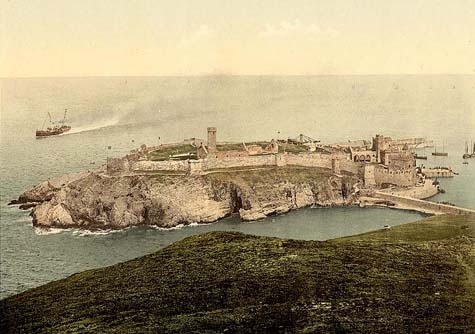
 [Image: Caerlaverock Castle, Dumfriesshire; Peel Cathedral, Isle of Man; castle in Aberystwyth, Cardiganshire; castle in Kidwelly, Carmarthenshire; Peel Castle, Isle of Man; and Ballower Mount, Ramsey, Isle of Man; all via
[Image: Caerlaverock Castle, Dumfriesshire; Peel Cathedral, Isle of Man; castle in Aberystwyth, Cardiganshire; castle in Kidwelly, Carmarthenshire; Peel Castle, Isle of Man; and Ballower Mount, Ramsey, Isle of Man; all via 


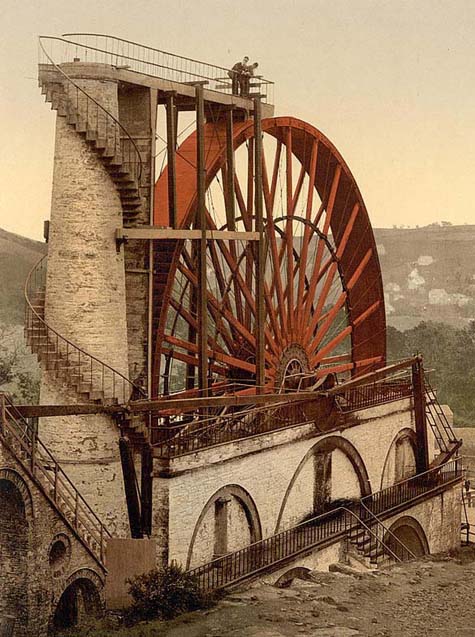
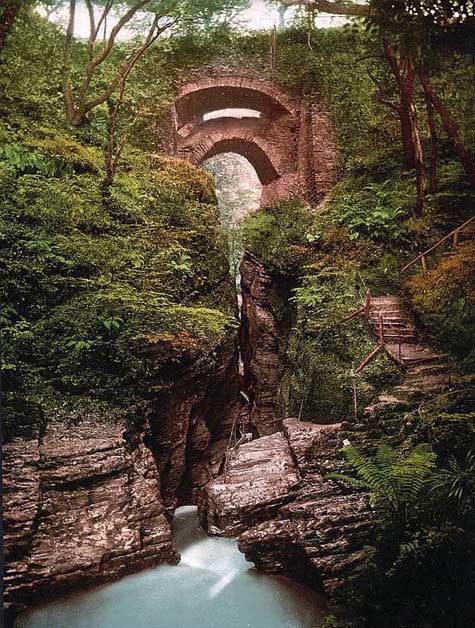
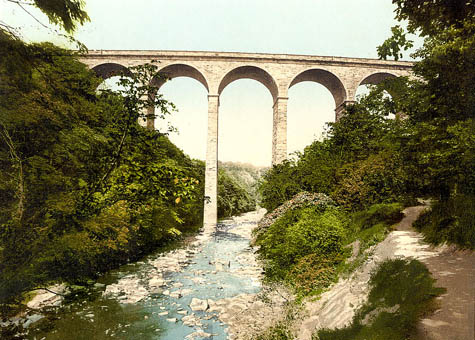

 [Images: Castle at Bolsover, Derbyshire; castle in Kidwelly, Carmarthenshire; bridge in Carmarthen, Carmarthenshire; the Wheel at Laxey, Isle of Man; Devil’s Bridge, Aberystwyth; Templand Bridge, Cumnock, Ayrshire; The Blackrock in Cromford, Derbyshire; entrance to a cave outside Castleton, Derbyshire; all via
[Images: Castle at Bolsover, Derbyshire; castle in Kidwelly, Carmarthenshire; bridge in Carmarthen, Carmarthenshire; the Wheel at Laxey, Isle of Man; Devil’s Bridge, Aberystwyth; Templand Bridge, Cumnock, Ayrshire; The Blackrock in Cromford, Derbyshire; entrance to a cave outside Castleton, Derbyshire; all via 


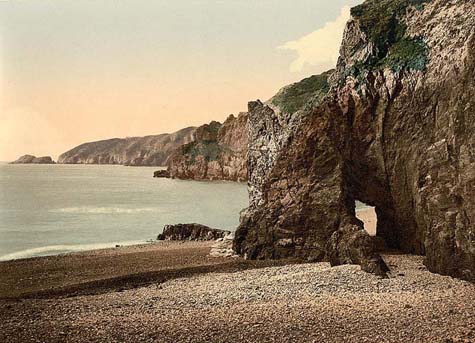

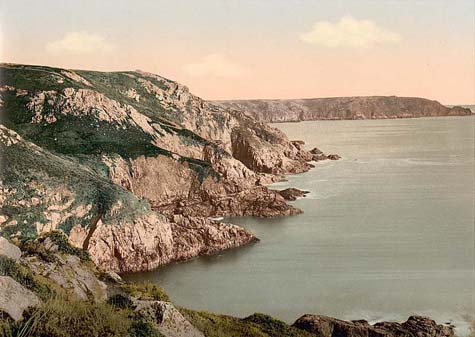

 [Images: Castle in Llanstephan, Carmarthenshire; Petite Bot, Guernsey, Channel Islands; La Coupee, Sark, Channel Islands; Dixcart Bay, Sark; Sugarloaf Rock at Port St. Mary, Isle of Man; the coast at the Gouffre, Petite Bot, and the harbor at La Moye Point (3 images), Guernsey; via
[Images: Castle in Llanstephan, Carmarthenshire; Petite Bot, Guernsey, Channel Islands; La Coupee, Sark, Channel Islands; Dixcart Bay, Sark; Sugarloaf Rock at Port St. Mary, Isle of Man; the coast at the Gouffre, Petite Bot, and the harbor at La Moye Point (3 images), Guernsey; via 
 [Images: Garth’s Pier in Bangor, Caernarfonshire, and a view of Bangor from Anglesey, via
[Images: Garth’s Pier in Bangor, Caernarfonshire, and a view of Bangor from Anglesey, via  [Image: The lighthouse at Corbiere, Jersey, Channel Islands, via
[Image: The lighthouse at Corbiere, Jersey, Channel Islands, via  [Image: Moulin Huet, Guernsey, Channel Islands, via
[Image: Moulin Huet, Guernsey, Channel Islands, via  [Image: The face of Nicholson Crater, Mars, courtesy of the
[Image: The face of Nicholson Crater, Mars, courtesy of the  In his most recent trilogy –
In his most recent trilogy –  In the following interview, then, Kim Stanley Robinson talks to BLDGBLOG about climate change, from Hurricane Katrina to J.G. Ballard; about the influence of Greek island villages on his descriptions of Martian base camps; about life as a 21st century primate in the 24/7 “techno-surround”; how we must rethink utopia as we approach an age without oil; whether “sustainability” is really the proper thing to be striving for; and what a future archaeology of the space age might find.
In the following interview, then, Kim Stanley Robinson talks to BLDGBLOG about climate change, from Hurricane Katrina to J.G. Ballard; about the influence of Greek island villages on his descriptions of Martian base camps; about life as a 21st century primate in the 24/7 “techno-surround”; how we must rethink utopia as we approach an age without oil; whether “sustainability” is really the proper thing to be striving for; and what a future archaeology of the space age might find. [Image: Refugees gather outside the Superdome, New Orleans, post-Katrina].
[Image: Refugees gather outside the Superdome, New Orleans, post-Katrina]. [Image: New Orleans under water, post-Katrina; photographer unknown].
[Image: New Orleans under water, post-Katrina; photographer unknown].



 [Images: Mars, courtesy of NASA].
[Images: Mars, courtesy of NASA]. [Images: (top) Michael Reynolds, architect. Turbine House, Taos, New Mexico. Photograph © Michael Reynolds, 2007. (bottom) Steve Baer, designer. House of Steve Baer, Corrales, New Mexico, 1971. Photography © Jon Naar, 1975/2007. Courtesy of the Canadian Centre for Architecture, from their excellent, and uncannily well-timed, exhibition
[Images: (top) Michael Reynolds, architect. Turbine House, Taos, New Mexico. Photograph © Michael Reynolds, 2007. (bottom) Steve Baer, designer. House of Steve Baer, Corrales, New Mexico, 1971. Photography © Jon Naar, 1975/2007. Courtesy of the Canadian Centre for Architecture, from their excellent, and uncannily well-timed, exhibition  [Image: American President Jimmy Carter dedicates the White House solar panels, 20 June 1979. Photograph © Jimmy Carter Library. Courtesy of the
[Image: American President Jimmy Carter dedicates the White House solar panels, 20 June 1979. Photograph © Jimmy Carter Library. Courtesy of the  [Image: Photos of Greece, inspiration for life on Mars, taken by Kim Stanley Robinson].
[Image: Photos of Greece, inspiration for life on Mars, taken by Kim Stanley Robinson]. [Image: A photograph of Santorini taken by Kim Stanley Robinson].
[Image: A photograph of Santorini taken by Kim Stanley Robinson].
 [Image: Two painted views of a human future on Mars, courtesy of NASA].
[Image: Two painted views of a human future on Mars, courtesy of NASA]. [Image: Architecture in Antarctica, photographed by Kim Stanley Robinson].
[Image: Architecture in Antarctica, photographed by Kim Stanley Robinson]. [Image: Shackleton’s hut, Antarctica, photographed by Kim Stanley Robinson].
[Image: Shackleton’s hut, Antarctica, photographed by Kim Stanley Robinson]. [Image: The Crucifixion as seen via Google Earth; by
[Image: The Crucifixion as seen via Google Earth; by 

 [Image: Biblical scenes as seen via Google Earth; by
[Image: Biblical scenes as seen via Google Earth; by  [Image: Chartres Cathedral as rendered in
[Image: Chartres Cathedral as rendered in  [Image: The Kaiser Shipyard’s
[Image: The Kaiser Shipyard’s  [Image: The warehouse at night, photographed by
[Image: The warehouse at night, photographed by  [Image: Nested salt shakers spotted on Dezeen… Wait a minute – it’s
[Image: Nested salt shakers spotted on Dezeen… Wait a minute – it’s  [Image: Illustration by Andrew Norfolk for
[Image: Illustration by Andrew Norfolk for